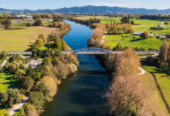
Cambridge nurse Linda Veale, who died treating Influenza patients in 1918. Photo: Supplied
As a lethal form of influenza ravaged its way across New Zealand in November 1918, Cambridge nurses Linda Veale and Margaret Watt worked quickly to transform the Town Hall into an emergency hospital.
On November 21, Veale, Watt and a small team of doctors and nurses housed and treated Cambridge’s 31 serious cases of the disease.
Their efforts are a reminder that the Covid-19 outbreak is not the first pandemic the people of Waipa have been through, nor the most serious.
Soon after, the pandemic peaked in Cambridge.
By November 26, the temporary hospital was housing up to 50 people.
Unlike most of the patients they treated, Veale and Watt didn’t survive. Veale succumbed, on December 7, 1918, to a disease that eventually killed 50 million people worldwide: the “Spanish Flu.” She was 41.
Watt died in January, according to Council funeral records. The nurses were two of five Cambridge residents reported to have died from the Spanish Flu.
At Veale’s funeral in December four soldiers acted as pall bearers. A New Zealand flag was draped across her coffin, which is buried in Hautapu cemetery.
“For many years there were plaques commemorating [the two] nurses in the Town Hall,” Cambridge Community Board Chairman Sue Milner said.
The News understands the plaques are no longer there.
December also marked Waipa’s emergence from the peak of the pandemic in mid-November.
Cambridge, with a population of about 1500, got off lightly. The fatality rate was one of the country’s lowest.
There were a group of “lucky towns with low death rates,” Kathryn Parsons, Manager at the Cambridge Museum said. “Cambridge was one of them.”
The Cambridge-based Waikato Independent—the major local paper of the time—commended the actions of locals as part of the reason the town was able to weather the worst of the pandemic so well.
On December 10, the Independent wrote: “The town is looking really fine at the moment and the person who is not proud that he lives there should be escorted to the railway station.”
“Remarkably, [Kiwis] kept their heads … they’d had four years of war and people were more accustomed to obeying orders. They helped each other.”
Residents praised Veale and the team of Town Hall nurses. “I desire to ex-press my sincere thanks to the nurses and assistants at the Cambridge Temporary Hospital for the care and kindness… and also the neighbours… who performed many acts of kindness during this anxious time,” resident J. Grainger wrote in a letter to the paper.
Te Awamutu—then with a population of just over 1000—was hit harder. A total of 24 people died there, and its death rate was one of the highest in the Waikato.
A temporary hospital was also set up in the Te Awamutu Town Hall and 52 people were admitted in 14 days.
“You think this is all new… but when you look at [the 1918 Pandemic], they had schools closed, public paths disinfected…” said Parsons.
All public buildings closed, mass gatherings were banned, school children sent home, public meetings and church services called off and footpaths disinfected.
“The Cambridge Borough Council was soon asking for voluntary aid to assist families in distress,” reads an article by the Museum.
Geoffrey Rice, author of the book Black November: The 1918 influenza pandemic in New Zealand told the New Zealand “the big lessons from 1918 were that delay is dangerous and complacency kills”.
“Remarkably, [Kiwis] kept their heads … they’d had four years of war and people were more accustomed to obeying orders. They helped each other.”
Soldiers returning from the First World War likely brought the pandemic to New Zealand in early October.
By the time the disease had eased in December, 9000 New Zealanders had died. It is estimated 2500 were Māori.
The Māori death rate was eight times that of Europeans and it is thought one in three deaths went unrecorded.
As Cambridge’s outbreak came to an end in December, the Waikato Independent had a message for the people of Cambridge.
“The epidemic has in the majority brought out the splendid qualities … the heroic self-sacrifice shown by hundreds during this time of sorrow and affliction demonstrates that the community still clings to the golden rule.”








